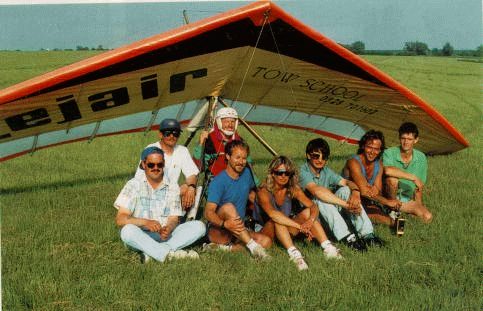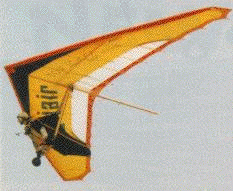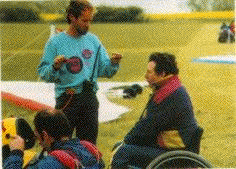

Most pilots learrn to fly for various strange reasons. My reason was to reduce my crashing activities with model aeroplanes. I felt that if I were aboard, maybe I would not crash so much! So in 1979 I joined John Clarke in the Peak District for 5 days of training. I did crash less, and here began my Long Time of Learning. Flying top-to-bottoms from 200ft, I felt quite chuffed; well you do don't you? However 3 years later, after visiting several different schools, I was still flying top-to-bottoms; this time from sand hills near Sydney in Australia. The climate was much better but my flying was not. I worked for Steve and Bill Moyes, who did their best to help with encouragement and even a dual flight with Steve. Fed up with this slow progress, I started to think that towing systems, which were available in the States, would be the only way to improve.
With our Australian visas running out, Rona and I planned to visit Donnel Hewitt in Texas on our way home. Donnel was an engineering lecturer in Kingsville. He welcomed us and was delighted to explain and demonstrate the new safe system, which he called Skyting. Previously, several fatal accidents had occurred when launching gliders, reinforced for towing loads with stainless steel and cable-towed by boats and jeeps. Donnel's approach was very logical and systematic; in 6 flying days he taught me to take off and land using an old Standard, later progressing to 500ft circuits on his Gemini. At last I felt I was really flying.
Donnel used a fixed length of line hooked to the back of his truck. He would sit in the back with the door open and his hand on a release, while his wife drove the truck and watched the tension gauge. This may sound strange, but it wasn't as bizarre as the photos Donnel showed me of his earlier prototype system: this involved a 750cc motorbike with him sitting on the pillion facing backwards! The fixed-line truck system, however. is very safe and is now used all over Australia very successfully, but they do have a lot of space over there! It wasn't difficult to recognise the potential of the system for club and school flying in Britain.
January 1984 saw us shivering on a disused airfield in East Anglia. Rona and I and some friends began towing, but we were only getting about four or five launches a day using Donnel's system. . The bridle was complicated and suffered when dragged over concrete. It wasn't long before I'd modified the bridle to make it easier to use. I combined a threader system with Mike Lake's (Norfolk Hang Gliding Club) towing-leg. Release could be accomplished with little difficulty using a string alongside one upright, making it easy for students to operate. The system worked extremely well, giving excellent hands-off stability although it's a little clumsy we still use it today for training purposes. The next thing to alter was the long line. Dumping lots of line over ploughed fields is not a good idea. We got the use of a payout winch from the Norfolk club. This was a Swiss idea. The line slipped out at a fixed tension, rather like a fishing reel. The winch was mounted in a trailer and pulled by my old Cortina. And the whole system worked!
With our new method the hang glider and winch began only 100 yards span at launch. The cortina would roar off down the runway and the glider climbed out, demanding line all the way to 2,000ft if you tried hard. The cable was then drawn back onto the drum. For low-level training flights the car would creep into wind while we ran alongside with the tethers. The advantage of the trailer was that at the end of a training flight we couid load the glider on to it and drive back to the launch point, which was a great convenience.
We got better at it over the next few years, improving our launch rate up to 40 a day depending on the battery life of the winch rewind. Rona and I spent a couple of years driving around the country teaching other club flyers how to cable launch. This was a lot of fun, but the cowpats and the bumpy fields full of sheep that we had to use eventually got the better of Rona and the Cortina. Long disused runways were better and our area had many of them, but in the mid-80's that same concrete was making a good price as hard-core for motorways.

Rona Webb gets away on the line
The club had grown to 25 and the school had been recognised by the then BHGA. As our runways were sold off we committed ourselves to buying our first Koch static winch which allowed us to continue using grass fields. The winch was expensive but the benefits soon stopped us worrying about it. We could make 100 launches a day and the grass was better to run on. We soon devised a great system for training and high flight club launching side by side.
The students attending the school would make between 6 and 8 launches per day on a pay-as-you-fly basis. We found that student progression was best at this rate and that bent aluminium was kept to a minimum. We devised a new performance estimate based on 'best L/D'; best results from students showed as a high L/D (L-progression; D=bent tubes). Progress was swift but steady and we were able to monitor in a professional manner. Solo flying would normally be acheived on Day 2, and 500ft cirsuits were usually reached on Day 5. 2 days or 15 circuits later, students would be flying fully prone on 4th-generation gliders.
The students came into contact with the Norfolk club on the same field during training, making their transfer into the club environment very natural. With the help of Phil and Angie Chettleburgh the club grew to a membership of over 40 and was able to purchase its own winch. Cohabiting with cowpats and agricultural machinery became more and more difficult. Often we would have to move machines and wait for the cows to go in for milking. We would be squeezed into tree-surrounded fields during the peak growing season. At these times we would drive off to the sand flats in front of Hunstanton's 70ft cliffs, where we could handtow or bungee launch each other into coastal lift This was a lot of fun. I tried to save on leg power by building a sand buggy for towing, but the salt took its toll and it never proved very practical, although an 800' launch was never a problem.
In late 1989 I gambled on renting our own field at Hill Farm, to be paid for by the school and the club pilots. I got the go ahead from the farmer but not all the pilots were as keen. There followed difficult times, until 1990 when the Norfolk club acquired a second winch system and a second site at RAF Sculthorpe, where a more independent club activity could flourish. The majority remained at Hill Farm preferring to continue sharing the school's facilities.
The Hill Farm site is set in open tree- less land in Norfolk, well positioned for cross country potential. The forty acres of short grass allows the club to use the longest runs, with the school area over to one side. Now we have runways on the other side, for aerotow launches. Discipline on the field seems to follow easily with this layout. Our height gain in light winds is only 500ft but it is amazing to see skillful pilots climbing slowly out on their way to cloud base. The proof is our cross-country record for the last 2 years, averaging 1,000 miles a year. Occasionally adjacent fields are available to us, improving the height gain to l,500 feet, Aerotow activities take away the luck element of cable launching and deposit us regularly at 1,000ft in the vicinity of lift. As a result our cross-country mileage went up to 1,264 in 1993 and we are hoping for 2,000 miles in 1994.
Taking stock in late 93, the club has 2 Koch systems and 2 sites and can manage 100-plus launches on a good day. The school has a dozen training wings, 2 Koch winches, a workshop and storage area, a lounge and a classroom. A typically busy summer's day at the field will see 200-plus training launches at a rate of about 20 per our. We also have a microlight for which our aerotowing syndicate built a hangar which was severely damaged by a storm in late October so we will need a new one of better design this year. The hangar also serves as the centre for the social activities of the club, with a number of memorable barbecues and mass camping on the field.
Cable launching depends on co-operation between pilots and ground crew. In the early days, success depended on the few winch qualified individuals (winch,slaves), who would be forced into winching for hours. Recently attitudes have changed, we believe that all who fly should learrn to winch, and this has been working well. All other jobs are shared on an hourly basis, i.e. bike riding, launch directing etc. Cable launching in the future will include all forms of tow systems with a variety of flexwings fixed-wings and foot or wheel launched aircraft. The microlight tugs will introduce a variation in airmanship which will encourage pilots from other disciplines to join in with our gliding activities. I see the use of wheeled-launch hang gliders offering an easy cross-over route from a vanety of existing pilots into gliding, and a useful opponunity for hang glider pilots to learn microlight landing skills. The fixed-wing foot-launch Swift will go a long way towards bridging the gap between sailplaning and hang gliding.
The advances that Simon Gillingham has made in dual instuuction in the southwest will eventually allow us to use dual teaching as a support to the well established tow system. The possibilities that dual training offers in coaching pilots from the ab-initio stage right through to advanced cross county flying are tremendous. Disabled pilots will also be able to savour the joys of our sport, as already demonstrated by our own Steve Derwin. Steve, a paraplegic, joined us in May 1991 and two summers ago flew his Magic IV on aerotow in Hungary where he made soaring flights in convergence and made his first XC flight to a pub 5 miles from the airfield.

Tow training and club co-operation will continue to gain in appeal. Through co-operation it may be possible to eventually become site owners and perhaps be in a better position than many BGA sailplane clubs are at present. Current agricultural set-aside policy will free up some land which, with careful handling, could work to our advantage and provide cheap and affordable flying fields. I have believed from the beginning that our strength has been derived from co-operation between school, club, landowner and each other, after all we depend on the ground crew to get us airbome. As we move towards 40,000 launches, we see lots more flying and fun to be had. and so much further to go.